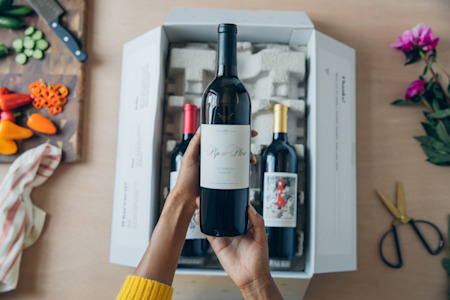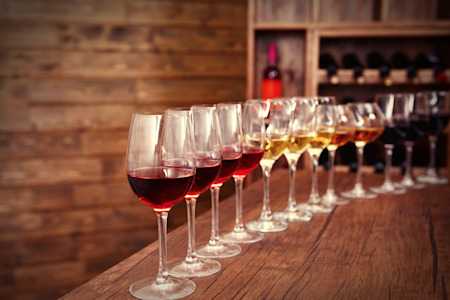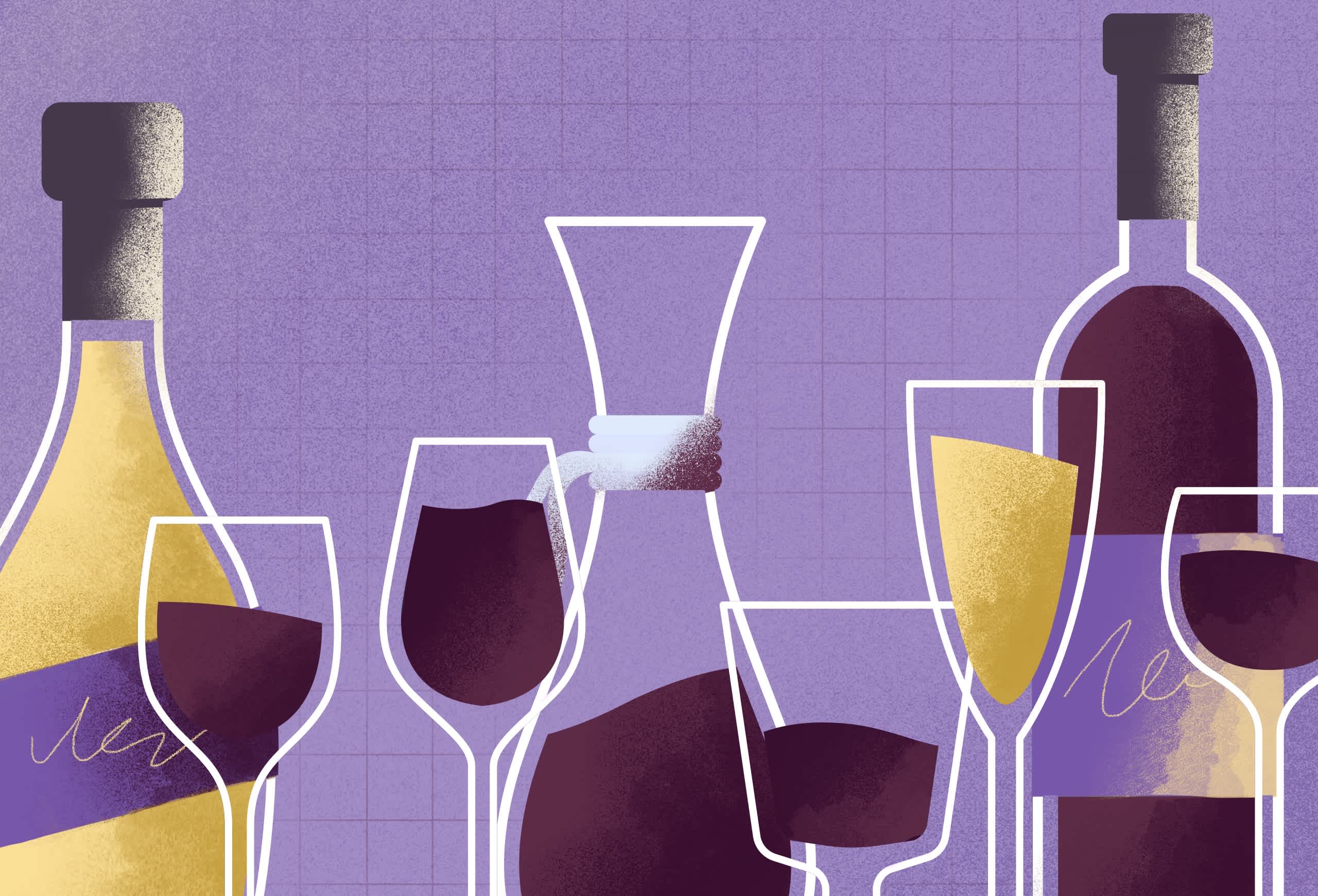Wine Glass Types
Learn about the different types of wine glasses and what you need for your wine.
Curious which wine goes in which wine glass? You can drink wine out of anything that can hold liquid, but having the right glassware can enhance your ability to taste complex flavors and assess the quality of a wine. For most wine drinkers a well-made universal wine glass will suffice. For those that want to get nerdy, there are specialty manufacturers like Austrian company Riedel that make wine glass types that are engineered in all kinds of shapes for every style of wine.
Wine is first and foremost a sensory experience. In almost every situation, drinking wine is about enjoyment, so if you get the most enjoyment from drinking wine out of a red solo cup or stemless wine glasses you should do that. Upgrading to nicer stemware is not necessary, but it can be helpful as you learn more about formally assessing wine taste.
But this is our ultimate guide to wine glasses, so we will break down the history of wine glasses, what types work best for different varietals, and even a few brands that we really like.

Take Our Quiz Today
Get award-winning delicious wines from all over the world shipped straight to your door. Take the quiz to get the perfect pairings for your holiday season.
Take The Quiz TodayIN THIS ARTICLE:
Want personalized wines?
Get your first box of wines for $44.95 + free shipping.

The History of Wine Glasses
Glass has been used for drinking since the time of the Pharaohs in Ancient Egypt. The ancient Greeks knew about glass, but typically drank out of ceremonial bowls. It wasn’t until the Romans that glass was widely adopted as a vessel for enjoying wine. Their glasswork was beautiful and delicate and used for decanters. But as the Roman Empire collapsed there were fewer and fewer craftsmen that retained the ability to make glass.
Fun Fact
The ancient Greeks typically consumed wine while reclining in a circle. The wine at the time was very different than what we drink today and often featured sediment. A game called Kottabos developed where they would take turns tossing the ends of their wine to a bowl in the middle of their seating area. You can imagine the mess! messy it probably was!
One of those places that retained the Roman traditions was Murano, a group of islands in the city of Venice linked by small bridges. Murano was the home of the glassmaking industry. Even today it's famous for its glassmaking, but in the Renaissance, it was the center of European technological advancement and they guarded their trade secrets jealously.
One of the largest leaps forward came with the invention of Cristallo, an incredibly fine glass that was often decorated with exquisite engravings. It was remarked to be one of the first attempts at producing clear glass. Venetian nobles began to request wine glasses that were shaped like dinner plates with stems. Guests using these glasses were expected to know how to drink without spilling any wine or breaking the delicate vessel. Want to drink some Italian wines like a Venetian noble? Head this way.
Fun Fact
All of the glassmakers were ordered to live on the island of Murano for the protection of their secrets as well as to protect everyone else from the highly flammable glass factories. If a glassmaker left the city without prior permission their families would be imprisoned, and if they refused to return an assassin could be sent to kill them. The desire to keep Murano at the top of the glassmaking world was fierce.
The finery of drinkware in Venice was countered by the much more utilitarian (and much more lasting) developments of 18th century England. A timber shortage in England led to the widespread adoption of coal which created a stronger glass, the hardships of the time forced innovation in production, and unwittingly produced a better product. This glass was the first iteration that we would recognize as bottles of wine today.
Around that same time, another English glassmaker discovered the technique for making leaded crystal, which was a significant departure from the Cristallo of Venice. The ability to make strong glass in varying shapes with precision led to the rise of wine glassware sets for different styles of wine.
Today certain regions (we're looking at you Alsace) still encourage drinking out of traditional glasses. In this case, tradition trumps innovation.
Why Glass?
While you can drink wine from anything that will hold liquid, it is widely held that glass is the superior vessel for wine. Why? Because unlike wood, silver, gold, or bronze, clean glass carries no other smells or flavors. The clarity helps wine drinkers assess a wine’s color and viscosity.
There are different types of wine glasses that have different features. The main features that can vary in wine glass shapes are:
The Rim: This is the lip of the wine glass and where your mouth comes into contact with the white wine, red white, or sparkling wine first. It’s believed that the thinner the rim the better, as it gets you closer to the aromas and the wine flavors. The rim is smaller than the bowl, and this shape is standard in wine glasses. A curved glass traps flavor and keeps you from spilling red wine in your lap when you swirl your wine.
The Bowl: The bowl is the widest part of the wine glass shape. Some wines, like Pinot Noir, need a larger bowl to capture delicate flavors and extend the surface area of the wine that comes into contact with oxygen.
The Stem: The stem comes down from the bowl and is intended for holding the wine. This allows you to have more control of the serving temperature as even short contact with the bowl can warm the wine past its ideal temperature. The stem is also crucial for swirling wine which adds in oxygen through the process of aeration in which aroma compounds are agitated to intensify the nose. Having a large bowl also helps with this.
The Foot: Also known as the base of the glass provides the stability a wine glass needs.
Wine Types and Glasses
For most wine drinkers the universal glass will do, but there are different glasses that are associated with a few specific types of wine that are designed to maximize flavors and textures of different styles. They aren't b.s., but they also aren't necessary to have an incredibly heightened experience with a glass of wine.
Sparkling Wine
Champagne flutes and coupe glasses have been traditional for bubbly, effervescent wine service. The problem is that a Champagne flute limits your ability to assess aromas, and the coupe quickly loses the carbonation and is easily spilled. Many sommeliers and wine professionals prefer to drink their sparkling wine out of a regular, universal wine glass than one of these specialties. Specialty Champagne glasses are increasingly seen as frivolous.

Shop award-winning wines from Firstleaf’s wine store.
Shop award-winning red and white wines in our wine store, shop by region, color, varietal, and more. Buy another bottle of your favorite wine or try a new one today.
Shop Wines NowBurgundy
Burgundy glasses are massive. These goblets have huge bowls to trap the delicate aromas of the Pinot Noir wines that come from the region. Some Burgundy red wine glasses have a tulip shape where the rim extends back out from the smallest point. These can be used as multipurpose Pinot Noir glasses if you have high-quality examples from other major growing regions.
Bordeaux
The big Cabernet Sauvignon flavors of Bordeaux don't necessitate quite the delicate touch that a Burgundian Pinot Noir might, and Bordeaux red wine glasses are similar in size to the average universal red wine glasses. This style can come in handy when you are drinking Zinfandel, Merlot, Malbec, Syrah (Shiraz), and on and on with popular red grapes.
Chardonnay
Chardonnay is another grape that needs a bit more glass than other white wines. Typical white wine glasses are smaller, but the richer, oaked varieties of Chardonnay, Viognier, and orange wines can benefit from a Chardonnay glass that is a bit bigger.
Dessert Wine Glasses
A dessert wine glass (sometimes called a port glass) has a narrow bowl to minimize evaporation and to hold on to the concentrated flavors.
Stemless Glasses
While this is not a glass type for a specific wine, stemless wine glasses can be good for your daily wine glass and are most assuredly dishwasher safe and easy to care for.
What Types of Wine Glasses Should I Buy?
If you are a new wine enthusiast and in the market for drinkware, we think that the first thing you should own is a universal red wine glass. A universal glass will allow you to drink red and white wines equally well. The wide bowl and long stem can highlight the flavors and textures while providing the correct wine temperature and aeration needed for most wines.
When choosing which wine glasses to buy you will see many advertising "hand blown glass", "Crystal", and "lead-free crystal." Crystal wine glasses are not as common as they once were, and most glassmakers produce lead-free crystal glasses that share the best qualities of Crystal and traditional glass.
There are hundreds and hundreds of brands you could choose from, but some of the nicest glasses come from Zalto and Riedel (pronounced Ree-dull).
The second set of wine glasses you should consider buying would be standard white wine glasses. These smaller bowls will be perfect for showcasing the acidity and fruit flavors in a Sauvignon Blanc as easily as they will with a complex Riesling.
We would like to again advise steering clear of a flute glass, as the narrow rim won't allow you to fully taste your Champagne, Prosecco, or Cava.
If you choose to move forward with buying more and more specific glassware, Riedel specialized in making glasses for every wine.
And once again, wine is about enjoyment. If you aren't holding formal wine tastings then these are not necessities, but they can help you get more from your next glass.
IN THIS ARTICLE
Want personalized wines?
Get your first box of wines for $44.95 + free shipping.


WinePrint™ by Firstleaf
Are you looking to learn more about your wine preferences? Check out our Wine Print for an in-depth look at your personal tasting profile. Discover your favorite wines, varietals, regions, and tasting notes and get personalized recommendations wherever you are.
Learn More